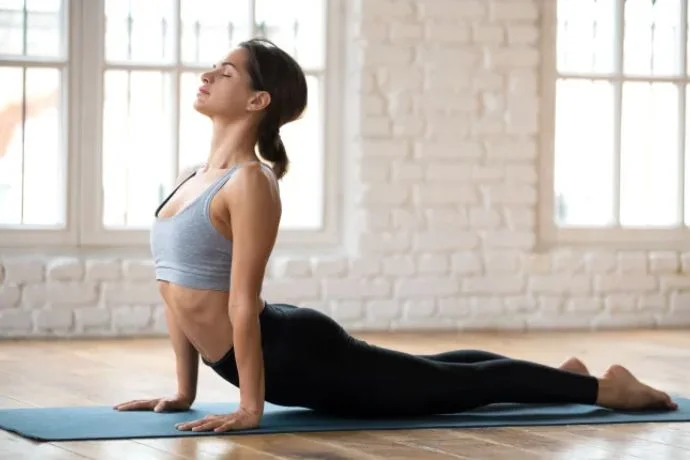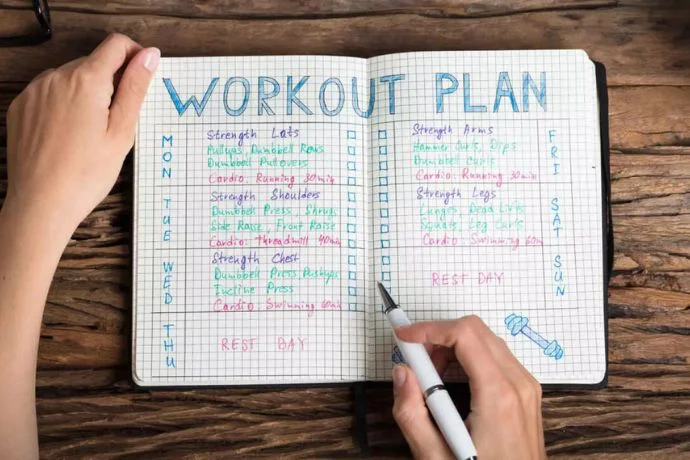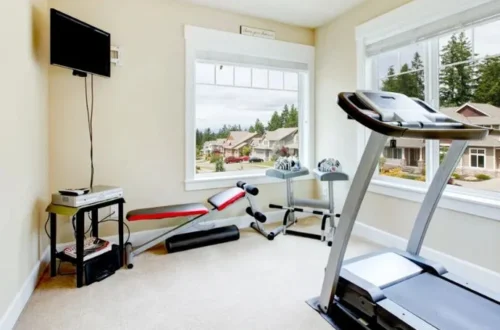My alarm had just gone off at 6:47 AM on a Tuesday. I had 23 minutes until I had to leave for work, but I had promised myself I wouldn’t miss another workout. The gym was out of the question, and I couldn’t do my usual hour-long workout. That morning, I learned something that would transform how I work out for good: the power of bodyweight workouts.
At first, I was just trying to get in some exercise, but now it’s my go-to option for hectic days. This practice has saved me a lot of times in the past year when things got busy, travel messed up my plans, or I just wanted a quick way to stay active without any equipment.
This full-body regimen that uses bodyweight workouts might be just what you need if you have a lot going on but don’t want to let your health take a back seat. You don’t need a gym membership, any equipment, or any excuses—just you, 25 minutes, and a promise to show up for yourself.

Why Bodyweight Exercises Are Perfect for Busy Lives
When I first started putting exercise first, I felt I needed a lot of free time and pricey gear. I was mistaken on both counts. Bodyweight exercises have distinct benefits that make them perfect for people with busy schedules.
The Science Behind No-Equipment Workouts
The American Council on Exercise says that bodyweight workouts can improve strength and muscular mass just as well as weight training. Your body naturally resists, and exercises like push-ups, squats, and planks work out several muscle groups at once, so you get more out of your time and money.
Convenience That Changes Everything
The best thing about workouts that don’t require any equipment is that they are easy to do. I can conduct this exercise in my living room before work, in a hotel room while I’m traveling, or even in my workplace during my lunch break. I don’t have to pay for a monthly membership, wait for equipment, or commute.
Time Efficiency That Actually Works
Most regular workouts take 45 to 60 minutes, plus the time it takes to get there. My short full-body workouts get the same benefits in just 25 minutes. This isn’t about taking shortcuts; it’s about getting the most done in the least amount of time. When every second counts, complex actions that work more than one muscle group at a time are your best friend.

My 25-Minute Full-Body Routine
After months of trying different things, I’ve come up with a regimen that works all of my major muscle groups and keeps my heart rate up. This fitness method saves time by combining strength training with cardiovascular benefits in one workout.
The Structure That Works
Warm-Up (5 minutes):
- 1 minute of shoulder rolls and arm circles
- 1 minute of hip circles and leg swings
- 1 minute of marching in place with high knees
- 1 minute of mild twists of the torso
- 1 minute of deep breathing and getting ready mentally
Main Workout (18 minutes):
Three sets of six exercises, each lasting 45 seconds with 15 seconds of rest in between. Take a break for 90 seconds between full circuits.
Cool-Down (2 minutes):
- 1 minute of mild stretching
- 1 minute of deep breathing and thinking

Circuit 1: Foundation Builders
These exercises that use your own body weight are the basis of functional strength. During this first circuit, I care more about having excellent form than about how fast I can do it.
Exercise 1: Push-Ups (45 seconds)
- Begin in a plank position with your hands a little wider than your shoulders.
- Bring your body down until your chest is almost on the floor.
- Push back up to the starting position
- Change: Do it on your knees or against a wall if you need to.
Exercise 2: Bodyweight Squats (45 seconds)
- Put your feet hip-width apart and stand.
- Lower your body like you’re sitting down on a chair.
- Keep your knees behind your toes and your chest up.
- Go back to standing up
Exercise 3: Plank Hold (45 seconds)
- Keep a straight line from your head to your heels.
- Keep your core tight and your breathing steady.
- If 45 seconds is too hard, hold on for as long as you can.
Exercise 4: Lunges (45 seconds, alternating legs)
- Take a step forward and get into a lunge position.
- Bring your back knee down near the ground.
- Push off with your front foot to go back to where you started.
- Change legs with each set
Exercise 5: Mountain Climbers (45 seconds)
- Get into a plank stance.
- Quickly switch between bringing your knees to your chest.
- Keep your hips level and your core engaged.
Exercise 6: Glute Bridges (45 seconds)
- Put your knees up and lie on your back
- Squeeze your glutes to lift your hips.
- Hold at the top for a moment before going down.
Circuit 2: Intensity Amplifiers
The second circuit makes things more intense. These no-equipment workouts are good for your heart and help you get stronger at the same time.
Exercise 1: Burpees (45 seconds)
- Begin by standing up, then crouch down and put your hands on the floor.
- Jump back into a plank stance with your feet.
- Do a push-up (optional)
- Jump your feet back into a squat.
- Blast up with your arms over your head
Exercise 2: Jump Squats (45 seconds)
- Do squats regularly
- Jump up and explode
- Land softly and then go right into the next squat.
Exercise 3: Pike Push-Ups (45 seconds)
- Begin in the downward dog position.
- Bend your elbows and lower your head toward the ground.
- Push back up to the starting position.
- This works the shoulders more than ordinary push-ups.
Exercise 4: Reverse Lunges with Knee Drive (45 seconds, alternating legs)
- Take a step back and lunge.
- As you stand up again, bring your back knee up to your chest.
- Change legs with each rep.
Exercise 5: Plank to Downward Dog (45 seconds)
- Begin in the plank posture
- Push your hips up and back into the downward dog position.
- Go back to the plank position
- This works on both your core and your shoulder mobility.
Exercise 6: Single-Leg Glute Bridges (45 seconds, alternating legs)
- Put one foot on the ground and the other leg straight out in front of you.
- Use only the leg that is grounded to lift your hips.
- Switch legs every few times you do it.
Circuit 3: Finishing Strong
The last circuit challenges you to your limits while keeping your form. These bodyweight exercises need you to stay focused and determined even when you’re tired.
Exercise 1: Diamond Push-Ups (45 seconds)
- Put your hands under your chest to make a diamond shape.
- In this narrow hand stance, do push-ups.
- This variant really works your triceps.
Exercise 2: Squat Pulses (45 seconds)
- Get down into a squat position
- Instead of standing up, move your body up and down in the bottom range of motion.
- Your legs will hurt, but keep going.
Exercise 3: Plank Up-Downs (45 seconds)
- Put your forearms on the ground and start in plank posture.
- One arm at a time, push up to a straight-arm plank position.
- Bring your lower back down to the forearm plank.
- Switch which arm is in front
Exercise 4: Curtsy Lunges (45 seconds, alternating legs)
- Put one leg behind the other and cross it over.
- Get into a lunge position that looks like a curtsy.
- Change legs and stand back up.
Exercise 5: High Knees (45 seconds)
- Run in place, lifting your knees up to your chest
- Pump your arms to make it harder.
- Pay attention to short, light steps.
Exercise 6: Superman Holds (45 seconds)
- Lie on your stomach with your arms stretched out above your head.
- Lift your legs and chest off the ground at the same time.
- Hold for a moment at the top, then decrease with care.

Progression and Modifications
One of the best things about bodyweight workouts is that you can make them harder or easier as you get stronger. You can change this practice to fit your level of fitness, whether you’re a novice or an accomplished athlete.
For Beginners
Week 1-2: Foundation Phase
- Cut your workout time down to 30 seconds and then take a 30-second break.
- Do only two circuits instead of three.
- Make easier changes, such as wall push-ups and half burpees.
- Learn how to do things the right way.
Week 3-4: Building Phase
- Work for 35 seconds and then rest for 25 seconds.
- Finish all three circuits
- Slowly go on to standard exercise modifications
- Start keeping track of your progress by counting repetitions.
For Advanced Athletes
Progression Options:
- For more of a challenge, add a fourth circuit.
- Make work periods last 50 to 60 seconds longer.
- Add versions that use only one limb, such as one-arm push-ups and one-leg squats.
- Do two exercises at once, like a burpee to a jump squat or a push-up to a T-rotation.
- Add isometric holds to hard situations.
Injury Modifications
Lower Back Issues:
- Standing knee raises should be done instead of mountain climbers.
- Change planks by raising your hands off the ground.
- Skip Superman holds or cut down on your range of motion.
Knee Problems:
- Do squats and lunges with less range of motion.
- Do regular squats instead of jump squats.
- When doing single-leg exercises, use a chair for support.
Shoulder Limitations:
- Make push-ups with your hands raised.
- Do ordinary push-ups instead of pike push-ups.
- Don’t do plank up-downs if they hurt.
The Mental Game of Quick Workouts
Time-efficient fitness isn’t just about how well you do things physically; your mental state is also a big part of whether you succeed or fail.
Overcoming the “It’s Too Short” Mindset
I used to think that workouts had to last a long time to work. This limiting belief hindered me from working out on days when I was busy. The truth is that 25 minutes of focused, hard bodyweight exercises can be better than an hour of gym time when you’re not paying attention.
Studies show that high-intensity interval training (which is what this practice is based on) works better in less time than standard steady-state exercise.
Building the Consistency Habit
Consistency, not perfection, is the key to success with workouts that don’t require any equipment. I keep track of my workouts with a basic calendar, where I note each one I finish. The line of X’s makes me want to keep going.
My 3 Rules for Consistency:
- Anything is better than nothing (even 10 minutes counts)
- Set aside certain times instead of hoping to find them.
- The night before, get your mind ready by picturing the workout.
Managing Energy and Motivation
When I don’t feel like working out, I tell myself that all I have to do is warm up. Nine times out of 10, once I get going, I finish the whole thing. Starting is usually the hardest part.
Fueling Your Quick Workouts
You don’t need to eat the same way for bodyweight exercises as you do for lengthier gym sessions, but eating right is still important for energy and recuperation.
Pre-Workout (30-60 minutes before)
For morning workouts:
- Big glass of water
- A small piece of fruit, as a banana or apple
- If you can handle caffeine, a little coffee is optional.
For afternoon/evening workouts:
- A light snack with both carbs and protein
- Greek yogurt with berries and an apple with almond butter are two examples.
- Make sure you drink enough water all day.
Post-Workout Recovery
These quick full-body routines create significant muscle protein synthesis despite their brevity:
- You should eat protein within 30 minutes, like a protein shake, Greek yogurt, or eggs.
- Drink water depending on how much you sweat.
- Add extra carbs to your diet to boost your energy.
Daily Nutrition Support
Regular time-efficient fitness routines increase your body’s demand for quality nutrition:
- Choose whole foods over processed meals first
- To help your muscles heal, eat protein at every meal.
- Don’t cut back on calories too much; your body needs food.
- To support your active lifestyle, pay attention to nutrient density.

Tracking Progress Without Equipment
To keep track of your progress with bodyweight workouts, you need to be creative. This is how I keep track of my progress:
Performance Metrics
Repetition Tracking:
- Count reps during timed breaks
- Keep track of when exercises get easier.
- Keep track of how you get better at harder varieties.
Endurance Markers:
- Time to recover between circuits
- Ability to keep good form over the whole workout
- How you feel hours after working out
Strength Indicators:
- Moving on to harder versions of the exercise
- More time spent in isometric positions
- Better balance and stability when doing workouts with one limb
Weekly Assessment Questions
Every Sunday, I honestly evaluate:
- How many times did I work out this week?
- Which exercises were easier than the previous week?
- What changes can I make to make it more difficult?
- How did working out regularly affect my mood and energy?

Common Mistakes and How to Avoid Them
After helping friends with this routine, I’ve noticed some typical faults that keep people from getting the best results:
Mistake 1: Sacrificing Form for Speed
The Problem: Moving quickly to get more reps done.
The Solution: Put quality over quantity. Every time, perfect form with fewer reps is better than sloppy form with a lot of reps.
Mistake 2: Skipping the Warm-Up
The Problem: Jumping right into hard workouts when you don’t have much time.
The Solution: The warm-up is not up for debate. It keeps you from getting hurt and makes you better at what you do. If you have to, skip some of the cool-down instead.
Mistake 3: Not Progressing Difficulty
The Problem: Doing the same thing over and over for months without changing it.
The Solution: Make the routine a little harder every two to three weeks. Your body gets used to bodyweight exercises quite quickly.
Mistake 4: All-or-Nothing Thinking
The Problem: If you can’t do the whole 25 minutes, don’t bother working out at all.
The Solution: Make a “minimum viable workout” plan; even 10 minutes of exercise is good.
Adapting the Routine for Different Scenarios
You can adjust no-equipment workouts to match your needs, which is why they are so fantastic. This is how I adjust my method for different situations:
Hotel Room Version
Modifications that take up space:
- Instead of jumping exercises, try step-ups on the bed or chair.
- Push-ups against the wall by the bathroom door.
- Instead of going forward or backward, do lunges in situ.
- Use towels to make some workouts difficult.
Office Break Version
Changes for a Professional Setting:
- Do isometric exercises that don’t make you sweat.
- Use stairs to do calf raises and step-ups.
- Push-ups on your desk and sit against a wall.
- Do exercises to help your neck and shoulders move better.
Outdoor Version
Changes to Fresh Air:
- Find a park bench where you can do push-ups on an incline.
- Do fun exercises with playground equipment.
- If you can, add stairs or hill sprints.
- Add stretches that incorporate trees to the cool-down.
Time-Crunched Version (15 minutes)
Ultra-Efficient Modifications:
- Cut the warm-up time to 2 minutes.
- Do only two circuits.
- Pick the 6 hardest exercises
- Skip the long cool-down, but keep breathing deeply.

Building Long-Term Success
Bodyweight training can help you stay fit for the rest of your life if you prepare ahead. Here’s how to make sure your success lasts:
Monthly Progression Planning
Month 1: Foundation
- Find out how to move in simple ways
- Make working out a part of your daily life and a habit.
- Focus more on consistency than on how hard you work.
Month 2: Development
- Make your workouts tougher
- Add different types of workouts
- Make it easier for you to move and provide you broader range of motion.
Month 3: Challenge
- Add more difficult exercises
- Try different times and frequencies for your workouts.
- Set clear goals for how well you will do
Month 4+: Mastery
- Make your own variations of exercises
- Show other people how to do the routine.
- Combine with other fitness activities
Seasonal Adaptations
Summer: Take workouts outdoors, add swimming-inspired movements
Fall: Focus on functional strength for hiking and outdoor activities
Winter: Emphasize consistency and mood-boosting movements
Spring: Prepare for increased outdoor activity with mobility work
Integration with Other Activities
This routine complements other forms of exercise rather than replacing them entirely:
- Use as active recovery between hard workouts
- Stay in shape when traveling or during hectic times
- Get ready for sports or other activities
- Basic strength for more difficult movements

Your 25-Minute Transformation Starts Now
After a year of using bodyweight workouts on hectic days, I’ve learned something really important: the gap between wanting to be fit and being fit is considerably smaller than I expected. It’s not about having a lot of free time or the best equipment; it’s about making a commitment to 25 minutes and showing up every time.
This regimen has helped me get through job trips, tight deadlines, family situations, and a lot of times when I said, “I don’t have time.” When life got crazy, it was my safety net for fitness, and when variety didn’t matter as much as convenience, it was my go-to option.
No-equipment workouts can change more than just your body. Moving around on a regular basis gives you more energy, makes you feel better, helps you sleep better, and raises your confidence in all areas of your life. Twenty-five minutes of focused work has consequences that endure all day.
Ready to make this routine your busy-day solution?
Here’s your action plan:
- Schedule your first workout: Block out 25 minutes in your calendar this week
- Prepare your space: Clear a small area where you can move freely
- Start with modifications: Use the beginner progressions if needed
- Track your completion: Mark successful workouts on a calendar
- Focus on consistency: Aim for 3 times per week to start
Don’t wait for the right time when your schedule is free; it will never happen. Don’t wait till you want to do something; inspiration comes after you do it, not before. Your body is all you need. Don’t wait for better tools or more room.
What do you say to yourself to keep from working out?What time? What kind of equipment? Space? Power? This regimen gets rid of all the usual things that stand in the way of getting healthy.
In just 25 minutes, you’ll be at your strongest and most energetic. The only thing you need to ask yourself is if you will take the first step today.
Begin with the morning of tomorrow. Set your alarm for 30 minutes early, set out some comfy clothes tonight, and promise yourself that you’ll only do the warm-up. I promise that once you start moving, you’ll want to do the whole program.
Your body will reward you, you’ll have more energy, and your busy days will be much easier to handle. The strength of bodyweight exercises is waiting for you. All you have to do is start.






